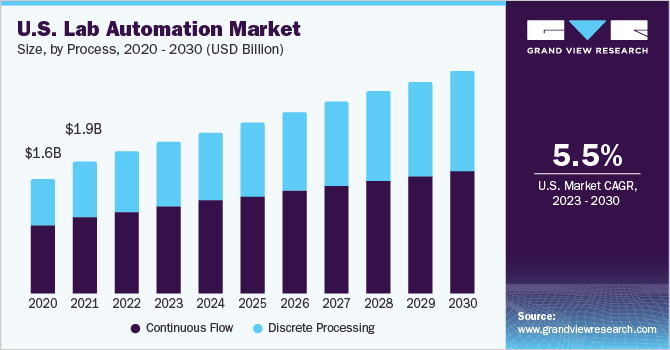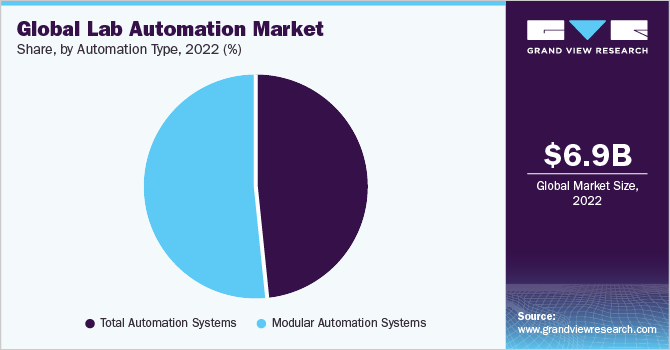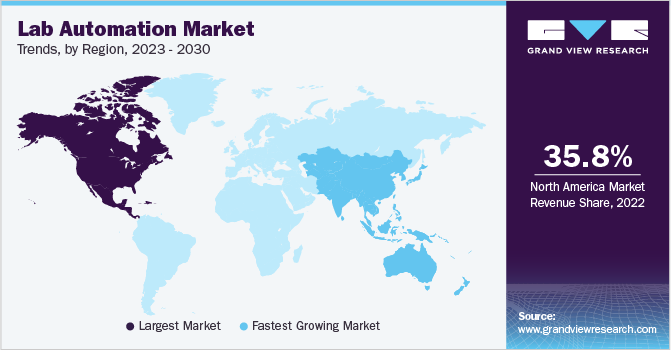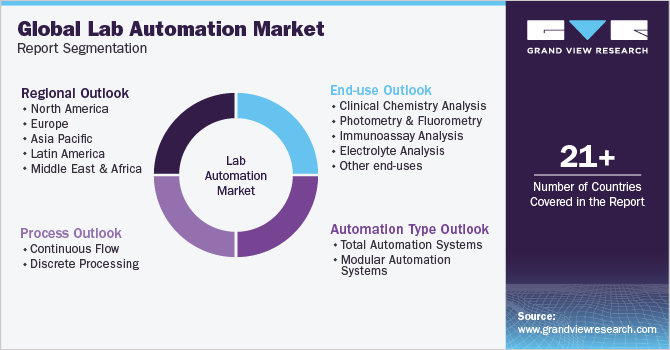
Lab Automation Market Size, Share & Trends Analysis Report By Process (Continuous Flow, Discrete Processing), By Automation Type (Total Automation Systems, Modular Automation Systems), By End-use, By Region, And Segment Forecasts, 2023 - 2030
- Report ID: GVR-4-68039-401-1
- Number of Report Pages: 130
- Format: PDF
- Historical Range: 2018 - 2021
- Forecast Period: 2023 - 2030
- Industry: Healthcare
Report Overview
The global lab automation market size was estimated at USD 6.87 billion in 2022 and is expected to grow at a compound annual growth rate (CAGR) of 6.64% from 2023 to 2030. Laboratory automation utilizes a special kind of technology to streamline or substitute the manual manipulation of methods and equipment. Based on the laboratory workflow, the level and degree of automation are decided. The higher adoption of automated instruments is most often observed at academic and research institutes to bolster productivity and decrease the time spent on different time-consuming tasks.

In addition, the rising use of automated instruments for drug discovery and development purposes is further anticipated to propel the market growth during the forecast period. For instance, in June 2022, Insilico Medicine announced its plans to launch an automated AI-driven robotics laboratory for drug discovery.
The increasing number of benefits offered by process automation is one of the critical factors driving the growth of the market. For clinical laboratories, a paradigm shift from manual operation to laboratory automation has several advantages. Some major advantages of lab automation include enhanced productivity, safe working conditions, reliable results, and a great saving of time, effort, and overall cost of the product.
Moreover, lab automation facilitates the efficiency of laboratory equipment for processes such as sample handling, verifications, and labeling tubes, and helps lower the physical strain due to manual processes. Thus, numerous benefits offered by automated systems are projected to facilitate small and medium-scale laboratories to use automated systems for enhanced productivity.
Increase in demand for miniaturization of the process is another factor driving the global market. One of the main reasons for the adoption of automated technologies in clinical laboratories is to accelerate the miniaturization of research processes to derive solutions for various complex lab automation processes for applications such as microbiology, biotechnology, and clinical chemistry. Moreover, miniaturization makes it simpler to expand, monitor, and cultivate cells, which speeds up turnaround times, particularly in point-of-care settings.
Moreover, the market growth is expected to be driven by the increasing range of applications for lab automation. Various laboratory processes that were formerly done manually have been revolutionized by lab automation. Automated chemistry, synthetic biology, cell line development, genomics, cellular assays, drug discovery, and other applications are among them. Therefore, the adoption of lab automation systems is anticipated to be fueled by the expanding clinical applications of automated instruments in laboratories.
Furthermore, the increasing demand for high throughput analysis in labs to process large numbers of samples is projected to offer significant growth opportunities for the market. Lab automation systems allow the automation of time-consuming and repetitive tasks like liquid handling, data analysis, and sample preparation thereby bolstering the output and facilitating research and testing capabilities.
Some of the recent product launches to support high throughput analysis are pushing market growth forward. For instance, in March 2023, Scientific Laboratory Supplies introduced Accuris Instruments AutoMATE 96 of Benchmark Scientific in the market. This fully automatic product boasts exceptional liquid handling capabilities, contributing to increased throughput in laboratory operations.
Process Insights
The continuous flow segment held the largest revenue share of 56.93% in 2022. The higher revenue growth of the segment is owing to the higher demand for continuous flow systems in industries and the surging adoption of continuous flow in laboratories for offering high-quality services. Moreover, continuous flow is among the widely preferred techniques and is also suitable when there is a need to analyze a large number of samples.
Also, robust demand for continuous flow processes in pharmaceutical and biotechnology companies and increased efforts by market players to introduce novel products with continuous flow processes are projected to drive segment growth. For instance, in October 2020 Sakura Finetek of Europe launched Tissue-Tek SmartConnect which allows automated continuous flow by connecting, processing, and embedding in the histology laboratory.
The discrete processing segment is projected to register the fastest growth rate of 7.34% throughout the forecast period. Several benefits of discrete processing over continuous flow are projected to bolster its adoption during the forecast period. Moreover, in this kind of sample processing, much space is provided for sample analysis thereby minimizing the chances of reagent wastage. Thus, owing to several advantages of discrete process it is projected to exhibit lucrative growth opportunities during the forecast period.
End-use Insights
Factors such as technological advancements, rising preference for automated laboratory instruments, and higher demand for automation in clinical chemistry labs for sample handling, storage, and labeling are contributing to the largest revenue share of 27.17% for the clinical chemistry analysis segment.
In addition, supportive government legislation, and flourishing demand from small and medium-sized laboratories are also projected to drive segment uptake. Recently market players have launched automatic lab systems for clinical chemistry analysis. For instance, in May 2021 Beckman Coulter launched DxA 5000 Fit, a workflow automation system for medium-sized labs.
Whereas the immunoassay analysis is projected to exhibit the fastest CAGR of 7.27% throughout the forecast period. Various advantages including accuracy, time and cost saving, easy data management & integration, and high efficiency are projected to bolster the demand for lab automation for immunoassay analysis.
Automation Type Insights
The modular automation systems segment dominated the market and accounted for the largest revenue share of 51.69% in 2022. The largest revenue share of the segment is attributed to the mix-and-match capabilities and flexibility capabilities offered by modular automation systems. In addition, the rising application of modular systems across end-users is another factor supporting market expansion. These kinds of systems are suitable for labs that need automation for specific processes.

Whereas, total automation is likely to be the fastest-growing segment with a CAGR of 7.15% over the forecast period. The rising demand for novel automation systems and the ability of these systems to offer customization services as per laboratory needs are projected to support segment growth. These systems are well suited for labs with high volume, and stringent quality control requirements.
Regional Insights
North America led the global lab automation market with a revenue share of 35.76%. The high growth of the region is attributed to, the presence of a well-established healthcare framework, and robust demand for automation systems across laboratories owing to speed, consistency, and precision. The market is also driven by rising demand for integrated laboratory systems and supportive government legislation for research.

Moreover, increasing demand for high throughput analysis and various strategic initiatives undertaken by players operating in the region are also likely to support market expansion. For instance, in February 2023 Automata, a leading provider of lab automation services announced its expansion in the U.S. With this expansion the company is planning to unlock new automation potential.
Asia Pacific is likely to be the fastest-growing region with a CAGR of 8.55% during the forecast period. Factors such as the rising number of small and middle-sized laboratories in the region, and increasing investments by market leaders in the region to launch novel systems are projected to fuel the regional market growth. Moreover, supportive government policies to facilitate lab automation is another factor supporting the expansion of the regional market.
Key Companies & Market Share Insights
The key players in the market are undertaking various strategic initiatives to maintain their market presence. In addition, these initiatives help players bolster their business avenues. For instance, in January 2023 Becton, Dickinson and Company (BD) launched its third-generation lab automation system for microbiology labs. The newly launched BD Kiestra is an ideal solution for automating lab specimen processing. Some prominent players in the global lab automation market include:
-
QIAGEN
-
PerkinElmer Inc.
-
Thermo Fisher Scientific, Inc.
-
Siemens Healthcare GmbH
-
Danaher
-
Agilent Technologies, Inc.
-
Eppendorf SE
-
Hudson Robotics
-
Aurora Biomed Inc.
-
BMG LABTECH GmbH
-
Tecan Trading AG
-
Hamilton Company
-
F. Hoffmann-La Roche Ltd
Lab Automation Market Report Scope
|
Report Attribute |
Details |
|
Market size value in 2023 |
USD 7.40 billion |
|
Revenue forecast in 2030 |
USD 11.60 billion |
|
Growth Rate |
CAGR of 6.64% from 2023 to 2030 |
|
Base year for estimation |
2022 |
|
Historical data |
2018 - 2021 |
|
Forecast period |
2023 - 2030 |
|
Quantitative units |
Revenue in USD million and CAGR from 2023 to 2030 |
|
Report coverage |
Revenue forecast, company share, competitive landscape, growth factors and trends Revenue forecast, company ranking, competitive landscape, growth factors, and trends |
|
Segments covered |
Process, automation type, end-use, region |
|
Regional scope |
North America; Europe; Asia Pacific; Latin America; MEA |
|
Country scope |
U.S.; Canada; UK; Germany; France; Italy; Spain; Sweden; Denmark; Norway; China; Japan; India; Australia; South Korea; Thailand; Brazil; Mexico; Argentina; Saudi Arabia; South Africa; UAE; Kuwait |
|
Key companies profiled |
F. Hoffmann-La Roche Ltd; QIAGEN; PerkinElmer Inc.; Thermo Fisher Scientific, Inc.; Siemens Healthcare GmbH; Danaher; Agilent Technologies, Inc.; Eppendorf SE; Hudson Robotics; Aurora Biomed Inc.; BMG LABTECH GmbH; Tecan Trading AG.; Hamilton Company |
|
Customization scope |
Free report customization (equivalent up to 8 analyst’s working days) with purchase. Addition or alteration to country, regional & segment scope |
|
Pricing and purchase options |
Avail customized purchase options to meet your exact research needs. Explore purchase options |
Global Lab Automation Market Report Segmentation
This report forecasts revenue growth at global, regional, and country levels and provides an analysis of the latest industry trends in each of the sub-segments from 2018 to 2030. For this study, Grand View Research has segmented the global lab automation market report based on process, automation type, end-use, and region:

-
Process Outlook (Revenue, USD Million, 2018 - 2030)
-
Continuous Flow
-
By Workflow
-
Sequential Processing
-
Parallel Processing
-
-
By Components
-
Consumables
-
Equipment
-
-
-
Discrete Processing
-
By Method
-
Centrifugal Discrete Processing
-
Random Access Discrete Processing
-
-
By Components
-
Consumables
-
Equipment
-
-
By Workflow
-
Dependent Analysis
-
Independent Analysis
-
-
-
-
Automation Type Outlook (Revenue, USD Million, 2018 - 2030)
-
Total Automation Systems
-
By Steps
-
Pre-analysis
-
Centrifugation
-
Sample Preparation
-
Sample Sorting
-
-
Transport Mechanisms
-
Liquid Handling
-
Sample Storage
-
Sample Analysis
-
-
-
Modular Automation Systems
-
By Steps
-
Specimen Acquisition & Identification & Labelling
-
Transport Mechanisms
-
Sample Preparation
-
Sample Loading & Aspiration
-
Reagent Handling & Storage
-
Sample Analysis & Measurements
-
-
-
-
End-use Outlook (Revenue, USD Million, 2018 - 2030)
-
Photometry & Fluorometry
-
Immunoassay Analysis
-
Electrolyte Analysis
-
Other end-uses
-
Clinical Chemistry Analysis
-
-
Regional Outlook (Revenue, USD Million, 2018 - 2030)
-
North America
-
U.S.
-
Canada
-
-
Europe
-
Germany
-
UK
-
France
-
Italy
-
Spain
-
Sweden
-
Denmark
-
Norway
-
-
Asia Pacific
-
China
-
Japan
-
India
-
South Korea
-
Australia
-
Thailand
-
-
Latin America
-
Brazil
-
Mexico
-
Argentina
-
-
MEA
-
South Africa
-
Saudi Arabia
-
UAE
- Kuwait
-
-
Frequently Asked Questions About This Report
b. The global lab automation market size was estimated at USD 6.87 billion in 2022 and is expected to reach USD 7.40 billion in 2023.
b. The global lab automation market is expected to grow at a compound annual growth rate of 6.64% from 2023 to 2030 to reach USD 11.60 billion by 2030.
b. North America dominated the lab automation market with a share of 35.76% in 2022. The growth is attributed to the presence of a well-established healthcare infrastructure, which has led to an increase in the adoption of lab automation systems in the region.
b. Some key players operating in the lab automation market include F. Hoffmann-La Roche Ltd; QIAGEN.; PerkinElmer Inc.; Thermo Fisher Scientific, Inc.; Siemens Healthineers; Danaher Corporation; Agilent Technologies, Inc.; Eppendorf SE; Hudson Robotics; Aurora Biomed Inc.; BMG LABTECH GMBH; Tecan Group Ltd.; and Hamilton Company.
b. Key factors that are driving the market growth include a rise in the gap between the availability of trained laboratory personnel and the demand for laboratory procedures and high reproducibility and accuracy obtained through lab automation.
We are committed towards customer satisfaction, and quality service.
"The quality of research they have done for us has been excellent."




